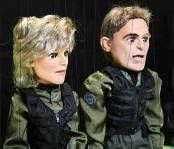At VFX World (please follow the link for the complete articles and to view the embedded video clips):
 Deconstructing Watchmen -- Part 1
Deconstructing Watchmen -- Part 1 In the first part of our in-depth
Watchmen coverage, we get an overview from
Alex McDowell, the production designer, and
John DJ DesJardin, the overall visual effects supervisor.
"Watchmen is all about details... it's all about telescoping time," McDowell insists. "The editorial tool is the way to turn the graphic novel into the film; you can get so much information across in a parallel way, and we approached the design that way. So this idea that you can embed these threads and cram stuff in parallel time really came across. But Watchmen is a traditional film in many ways. And for the designer, it's the density that's the challenge: the actual complexity was logistic. "There were many, many more sets than I've ever built in a movie (around 200) because of all the layering of time and space that we had to deal with, the character threads, there has to be so much material that has to be created to carry the story ..."
~~**~~**
Deconstructing Watchmen -- Part 2Sony Pictures Imageworks, Intelligent Creatures, MPC Vancouver, CIS Hollywood and Rising Sun Pictures discuss their contributions to
Watchmen in the final part of our coverage.
Tricks for Dr. Manhattan, Mars & VietnamNot surprisingly, the majority of the vfx revolves around Dr. Manhattan. Thus, with its 400 shots, Imageworks served as the lead vendor, under the supervision of
Pete Travers (Click, Zathura). "We did everything associated with Doc," Travers explains, "including the Martian environment, the Glass Palace, the destruction of New York City and [the rapid victory in] Vietnam."
Travers adds that it was "a dense 400 shots." In other words, there were no easy ones. "I came on in the summer of 2007. DJ [DesJardin], the overall visual effects supervisor, approached us and after reading the graphic novel, my first reaction was, 'We gotta do Doc!' DJ already had discussions with Snyder about the approach as a CG character that emits its own light, and I just reinforced that view ...
~~**~~**
Zack Snyder Talks WatchmenAfter our in-depth making of coverage, the
Watchmen director discusses bringing the landmark graphic novel to the screen.
Zack Snyder always knew that making
Watchmen was going to be a difficult journey: part fanboy exercise, part artistic indulgence. Yet strict fidelity to the landmark graphic novel was never the goal.
Production Designer
Alex McDowell will grant that much. "For Zack, it was really important to hit the 30 images that the fans carry with them from the graphic novel. And for himself: to know that those big beats would be respectful. But we made some big changes in the threads between those. One of the huge contributions Zack made to this -- which will really be apparent when you watch the film -- is that there are layers and layers of pop cultural reference on top of the Watchmen reference and on top of the pop cultural references already embedded in [the graphic novel]," he says. "Because we have the hindsight of 20 years and the knowledge that Apocalypse Now is embedded in the consciousness of the audience, if you want to play "The Ride of the Valkyries" over Vietnam, you've added an entire other reference layer that puts you in another space."
~~**~~**
Scott Lukowski Talks Conceptualizing WatchmenConcept Illustrator
Scott Lukowski discusses his experiences on
Watchmen and some other high profile movies.
Scott Lukowski is a very busy concept illustrator. While
Watchmen Production Designer
Alex McDowell recommended him for this interview, it turns out that he's also worked on the new live-action
Akira,
Alice in Wonderland (his second stint with
Tim Burton after
Big Fish),
Fantastic Voyage and
Surrogates. Prior to these, he contributed to
Transformers and
Zodiac. And, previously,
Lukowski worked in vfx by sculpting and fabricating miniature vehicles and architectural items from scratch as on-screen elements, including extensive work on
Titanic and minor contributions to
Stuart Little 2 and
Spider-Man.


